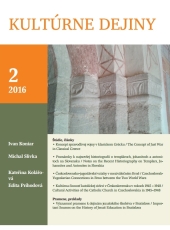Československo-jugoslávské vztahy v meziválečném Brně
Czechoslovak-Yugoslavian Connections in Brno between the Two World Wars
Author(s): Katerina KolářováSubject(s): History, Cultural history, Social history, Interwar Period (1920 - 1939)
Published by: VERBUM - vydavateľstvo Katolíckej univerzity v Ružomberku
Keywords: Brno; Czechoslovak-Yugoslavian connections; Czechoslovak-South Slavic League; 1918–1939;
Summary/Abstract: The present paper deals with the Czechoslovak-Yugoslavian connections in Brno between the two world wars. The pre-war tradition of these connections extended into the following period thanks to an academic society ‘Jugoslavija’, established by Yugoslavian students. The most signifcant contribution to the development of mutual relationships, however, was made by the branch of the Czechoslovak-South Slavic League, a national association where a number of important people such as Vincenc Hlavinka or Vladimir Fikulka worked. In Brno the League was focused on the aid to Yugoslavian students and it dealt with the issues such as the position of Yugoslavian minority in Italy or of the Croatians in Southern Moravia. An important role was played by cultural relationships, especially as regards theatre. In addition, there were many other areas of cooperation: agriculture, tourism, translations, lectures, teaching the Serbo-Croatian language, etc. The aim of the paper is to describe activities of the Brno branch of the Czechoslovak-South Slavic League and to highlight its signifcant role in the lives of people living in Brno between the two world wars as well as its leading position within the national body.The Czechoslovak-Yugoslavian inter-war relationships in Brno reflected the contemporary trends in Czechoslovakia. The mutual relations followed in the traditions established in the past, whether it was the period of the 19th century or the fnancial investments in Balkan, the development of Sokol [Falcon] or the era of the Balkan Wars in the 20th century. The paper deals with the period rightly called “the golden age of associational life”. A rich associational life also took place in Brno. Within the Czechoslovak-Yugoslavian connections in this city, a major role was played by an academic society “Jugoslavija” and especially by the Czechoslovak-South Slavic League – a national association with its own branches, one of them also in Brno.People, who were active in such an association, had different motivations. They could have been motivated by the affnity to national tradition or by sympathy for one of the Yugoslavian nations, but there may also have been personal motives, such as family relationships, war memories or other personal interests. Last but not least, there was also an interest in the Adriatic and a vision of easy travel to the sea. A key role in the organization and operation of these societies was played by the engagement and activity of a few dozens of enthusiasts. These were individuals who managed to attract the attention of their neighbours, overwhelmingly educated citizens of cities. The membership in these associations was explicitly a matter of urban middle class.The Czechoslovak-South Slavic League with its branches enjoyed the offcial support of the state, especially of the Ministries of Foreign Affairs and Education. Thus it had close relations with the establishment and as such it was a bearer and co-creator of the offcial image of the South Slavs and Yugoslavia. It was aimed at the propagation of the contacts between the state nations and their states.These matters more or less applied to each branch of the League, including that in Brno. Varied activities, from the student support, translation activities, through lecturing and cultural or other events of various kinds, up to the mutual attending of important events were also held in all cities where the League was active. Specifc for the Brno-Yugoslavian relations were the support for Moravian Croatians, ample activities in the area of stagecraft and the efforts for the expansion of the branch, which did not occur in other cities of inter-war Czechoslovakia.
Journal: Kultúrne dejiny
- Issue Year: 7/2016
- Issue No: 2
- Page Range: 217-256
- Page Count: 40
- Language: Czech

